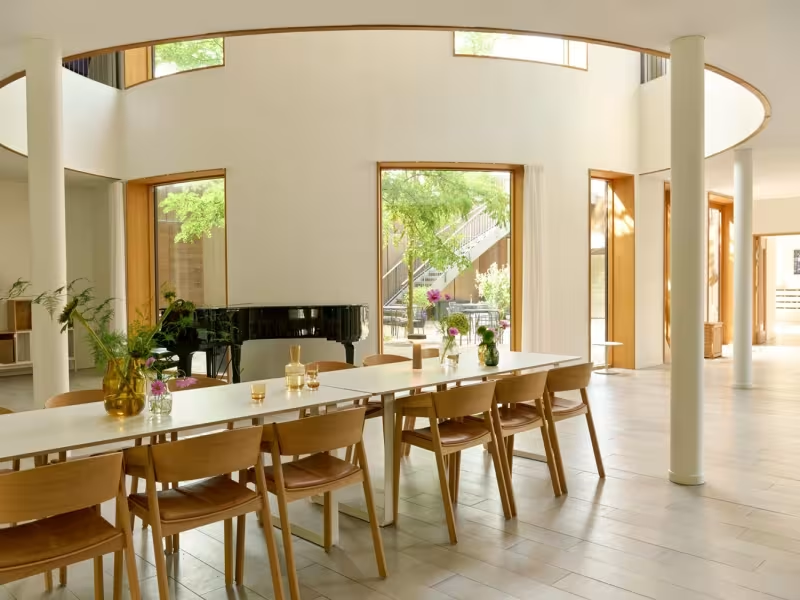
SHERIDAN, WYOMING – May 13, 2025 – Diakonissestiftelsen’s hospice in central Copenhagen is redefining the intersection of healthcare and human-centered design, using the principles of neuroaesthetics to transform how end-of-life care is experienced by patients, families, and staff alike. The hospice stands as a compelling case study in how thoughtfully designed spaces—driven by sensory awareness, biophilic elements, and intentional use of art and materials—can deliver both emotional and operational value within the care sector.
Neuroaesthetics and Strategic Design for Care Environments
Neuroaesthetics, the science of how aesthetics influence brain function and well-being, plays a foundational role in the hospice’s environment. Susan Magsamen, founder and executive director of the International Arts + Mind Lab at Johns Hopkins University, underscores the importance of sensory elements in care settings: “Lighting – particularly exposure to natural daylight – has been linked to improved patient outcomes and higher staff productivity and job satisfaction. Well-lit spaces can create a warm, welcoming atmosphere that fosters a positive environment and promotes the overall comfort of hospice patients and their families.”
Elements like color, light, tactility, and natural views are deliberately integrated to stimulate the brain’s reward system, helping to reduce stress, elevate mood, and support healing—even in palliative contexts.
A Model for Holistic and Human-Centered Care
Former hospice director Helle Tingrupp describes the facility’s guiding philosophy: “This hospice and its spirit was conceived as a space where care goes beyond the clinical to encompass the emotional, spiritual, and aesthetic needs of patients and their families. Over the years, we’ve learned that the environment plays a crucial role in the well-being of our patients.”
Design strategies are not only intuitive but deeply informed. The space includes flexible communal rooms, individualized patient areas, and a central courtyard designed to offer both community and privacy. Materials, colors, and furnishings are chosen for their emotional and tactile impact.
Key elements include:
- Use of soft, neutral colors to avoid sensory overload
- Customizable patient rooms for personal expression
- Biophilic design elements like natural light, greenery, and water features
- Art curation in collaboration with Ny Carlsberg Foundation
Driving Innovation Through Collaboration
Architecture and interior design are approached with a shared mission: creating serenity and dignity. Rounded layouts prevent institutional corridors; communal spaces are designed to support events like Friday dinners while also allowing for solitude.
"One of the most significant aspects of what we do is creating a welcoming and peaceful environment for patients and their families. First impressions are really important to us,” says Tingrupp.
Magsamen adds: “Research into environmental psychology suggests that we feel more connected to places that incorporate elements of nature or biophilic design. Natural light, plants, and natural materials can help reduce stress, improve cognitive function, and promote well-being and recovery.”
Operational Insights and B2B Relevance
For healthcare providers, developers, and design firms operating in B2B markets, Diakonissestiftelsen’s model presents a scalable blueprint for combining emotional intelligence with functional design. The integration of neuroaesthetic principles translates to tangible ROI in terms of improved patient satisfaction, staff retention, and care delivery efficiency.
This philosophy also aligns with Muuto’s design ethos, as the brand continues to explore neuroaesthetics through its products and partnerships. From modular furniture to curated accessories, Muuto’s presence in this project highlights how design-led thinking can empower the healthcare sector to create environments that are as emotionally intelligent as they are operationally sound.
Creating a New Standard for End-of-Life Design
“We strive to create an atmosphere that feels welcoming and serene, challenging the traditional, somber perceptions of a hospice. Our goal is to build a hospice that feels both like a home and a place of care,” says Tingrupp.
As the care industry continues to seek solutions that balance efficiency with empathy, Diakonissestiftelsen’s hospice is more than a facility—it’s a paradigm shift. It proves that compassionate care can be designed, measured, and implemented with purpose.
Learn more about Muuto's approach to neuroaesthetics at www.muuto.com